How to hire a Product Manager
First authored on Monday, 7th March, 2011 (updated November 2020)
Purpose
This article intends to explain how to recruit a Product Manager and to explain the basics of Product Management to people who don’t it on a daily basis.
Contents
- Super Brief Definition of a Product Manager
- The Pragmatic Framework
- Standard Job Descriptions
- Writing the Product Management job ad
- What attributes to consider when hiring a Product Manager
- How many Product Managers are required?
- Product Management for B2C Products
- Who should the Product Manager report to?
- Further Reading
- Feedback
Audience
Intended readers are senior management in technology companies, recruiters (internal HR and agencies) and prospective Product Managers themselves.
What motivated me to write this article originally
Product Management was a poorly understood role in the UK. I am very pleased to say that the level of understanding has increased by orders of magnitude. This article provides a baseline.
Without hesitation, I single out recruiters as the profession that can benefit the most from this article. With the correct consultative approach, external recruiters can advise their clients on industry best practice and lead their clients to both the right people and to lay the foundation for the right organisation-wide processes for product management and better and more efficient product development. From there, it is a small step to better products, better and more efficient sales and delivery processes and improvement in profitability - hurrah!
As a result, recruiters can gain a much greater insight into their clients’ operations and build a sustaining and differentiated value-added relationship (and generate more work orders too!).
Super Brief Definition of a Product Manager
Much of this article tackles this thorny question of what does a Product Manager do. So depending on your level of familiarity, the answer may be immediately below or spread throughout this article – sorry there’s no way of avoiding this!
The question, 'How would you define Product Management?', is often the first in any interview. The standard answers are:
- CEO of the Product. Reasonable definition. Personally, I like Steve Johnson’s definition: the ‘Parent of the Product – you want the product to leave and come back infrequently’.
- Messenger of the Market. This is the classic inbound product management definition – a product manager acts as the voice of the customer (or market) into development. It implies the reasoned advocate of the market, wishing to solve a business problem. I also like to Story Teller of Customer Use Cases.
- Personally, I subscribe to this: ‘the person responsible for ensuring the right and complete products are built at the right time for the right markets’, as it emphasises market entry and timing and that a product isn't simply working code.
Key point: product management is separate from product creation
Back in 1990s:
Chief Technology Officer = Product Manager +
Director of Engineering
Today’s software products require two different skills sets to tackle two different problems: the fundamental technology challenges and the market fit of products to business requirements. Hence why, today, this combined role has separated into its two logical constituents.
What does a Product Manager do?
There are many crimes committed under the guise of Product Management: the management of product strategy and tactics, its closely related function, Product Marketing, Marketing (and MarComms), Project Management and on and on … There’s a lot that could be added to the list – which is one reason why I love the job.
Product decisions impact other business functions that Product Managers don’t control – having an appreciation of the effect of one’s decisions makes it a fascinating and continually challenging role.
The Pragmatic Framework
THE industry-standard definition of all aspects of a Product Manager’s function is the Pragmatic Framework - formerly the Pragmatic Marketing Framework (see the Framework on Pragmatic Institute’s website for more details). Pragmatic Institute is the best-known training organisation for Product Managers, headquartered in the USA. To date, it has trained 200,000 product management and marketing professionals at 8,000 companies (Stats updated in Dec 2020).
Pragmatic Framework
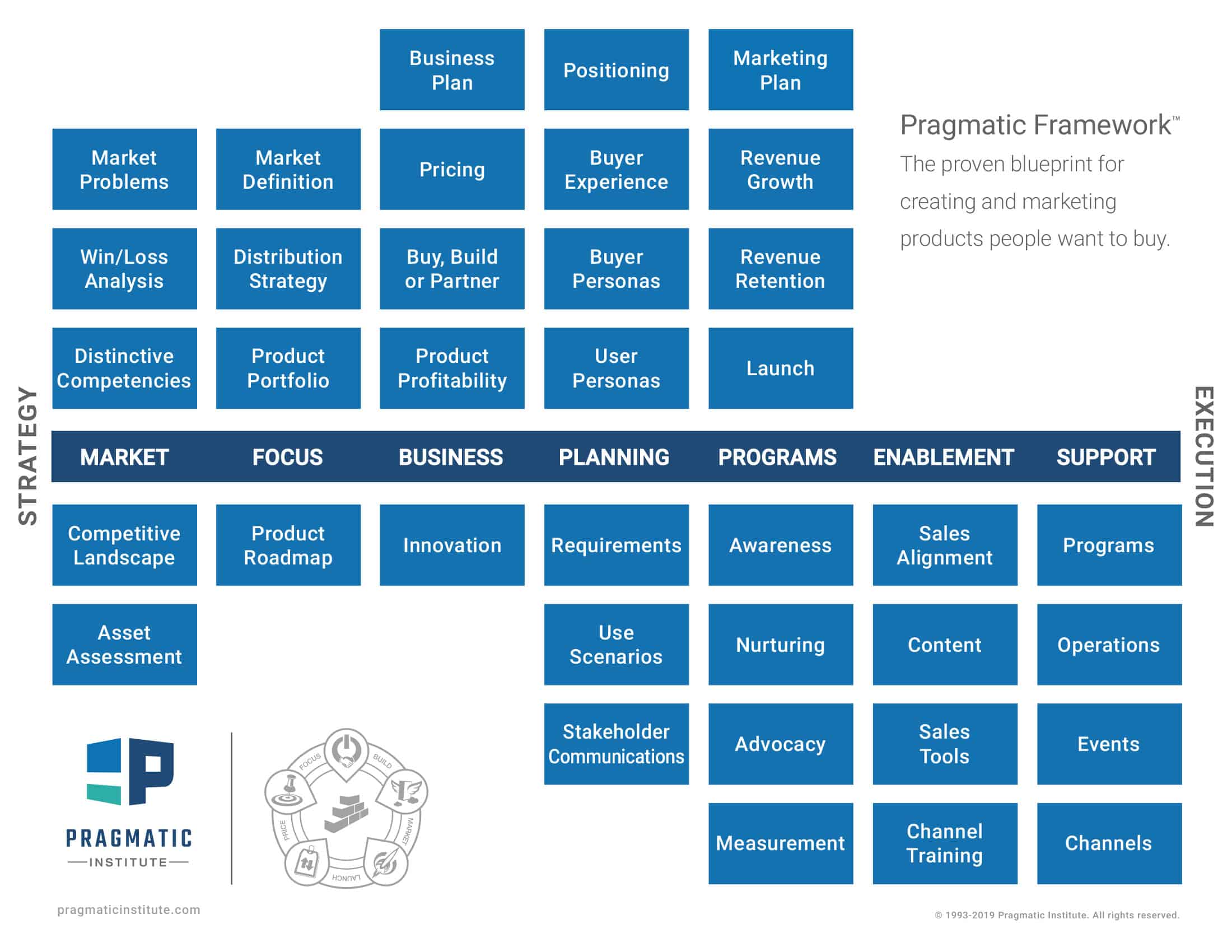
Arthur’s opinion of the Pragmatic Framework
This Framework isn’t prefect (particularly in start-ups), but it is what it says on the outside of the box – it’s a framework – it needs to be modified in order to fit into any given organisation.
Product Managers in small companies (ie many of those around Cambridge, UK) need to add some project management and some marketing to this mix.
Summary of the Pragmatic Framework
The functions of a Product Manager can be divided into three broad areas of responsibility:
- Strategic
- Technical
- Marketing
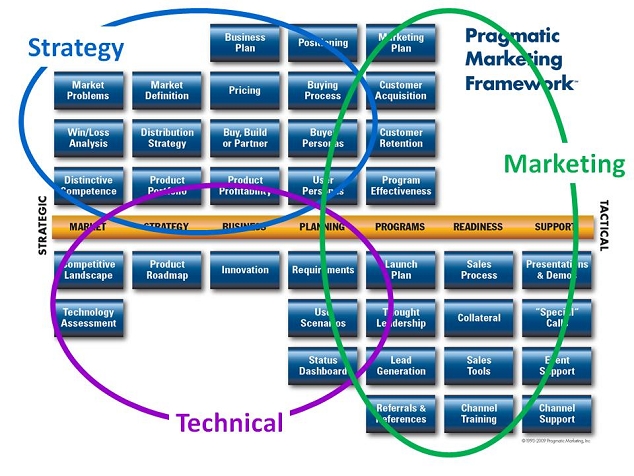
Source: The Product Management Triad
Note for those hiring PMs: very, very rarely, do you find a PM that is equally strong in all three areas. You find that every PM has his / her strengths or biases. I strongly encourage that:
- Recruiters: uncover which corner(s) are top priority to the hiring manager and which product management functions are secondary.
- Candidates: describe from which corner they approach Product Management. (For me, it is from the Strategic and Marketing corners.)
Steve Johnson (of Pragmatic Institute) has a simple litmus test to undercover someone’s strengths: ‘Which Microsoft Office product do you prefer?’
| MS Office Product | Core Product Management competency |
| Word | Technical |
| Excel | Strategic |
| PowerPoint | Marketing |
It is surprisingly accurate and disarming!
Standard Job Descriptions
From Pragmatic Institute: Sample Product Manager Job Description
KEY RESPONSIBILITIES
- Managing the entire product line life cycle from strategic planning to tactical activities
- Specifying market requirements for current and future products by conducting market research supported by on-going visits to customers and non-customers.
- Driving a solution set across development teams (primarily Development/Engineering, and Marketing Communications) through market requirements, product contract, and positioning.
- Developing and implementing a company-wide go-to-market plan, working with all departments to execute.
- Analyzing potential partner relationships for the product.
REQUIREMENTS
- 3+ years of software marketing/product management experience.
- Knowledgeable in technology.
- Computer Science or Engineering degree or work experience a strong plus.
Whilst we’re on this topic, here are some job descriptions for some associated roles:
- Sample Product Marketing Manager Job Description (source: Pragmatic Institute)
- Sample Software Product Architect Job Description (source: Pragmatic Institute)
Quick explanation of the difference between Product Management and Product Marketing:
"A Product Manager listens to the market; a Product Marketing Manager talks to the market."
Writing the Product Management job ad for your company
Rule 1: Start with a standard job description.
Rule 2: Review the Pragmatic Framework and be clear which components should be emphasised in the job description.
Rule 3: Be prepared to modify requirements as you meet candidates.
Rule 4: Do your very best to avoid HR writing the job description by themselves. Hint: you can point them to this article or get them to contact me if you wish!
In short, the PM job description (possibly more than any other position in the company – a highly contentious statement, I recognise!), requires compromise in the light of candidates and their potential. You won’t find the perfect candidate, it is essential to determine what is really required and what can be compromised and which personal attributes are necessary. This trade-off is often done during the recruitment process. (This is one reason why I have been invited to some pretty strange interviews in my time!)
Personality and cultural fit is NEVER written into the job description, but I estimate that it carries 50% of the ‘under-the-table’ evaluation of any candidate. Product Managers interface with so many other aspects of a corporation that common sense, an inbuilt understanding of different objectives of different business functions, cultural assimilation and having a sensitive corporate ‘antenna’ are essential requirements.
Shanky Job Descriptions and Corporate Weaknesses
My own search for a new PM position, I read some pretty ‘shanky’ job descriptions. As Product Management requires many skills sets that are used in other business functions, other departments see a PM as a resource that they can leverage. When other business functions are asked, ‘Can you review and amend the job description for our new Product Manager please?’, the reviewers throw in whole list of existing corporate weaknesses into the job description of the new Product Manager, making insightful competitive information.
- 'Experience with Whole Product Lifecycle' means that the company wants to sunset a product - which product is it??
- 'Strong Project Management Skills' means that Engineering needs help with the development scheduling.
- A high proportion of travel can mean that the Product Management is the 'demo boy' for Sales - indicating that Sales haven't got sales engineering sorted out yet.
Salary
Every year, Pragmatic Marketing carries out a survey of Product Managers. See the 2019 Survey, but do read the rest of the survey, as it is insightful!
What attributes to consider when hiring a Product Manager
This article, Degrees of Ability: Hiring Into Product Management in Pragmatic Institute's newsletter outlines four essential attributes of a Product Manager:
- Natural Talent is the set of basic abilities that people seem to have possessed throughout their career or school years. It forms the foundation of what they can do and how well they do it.
- Artful Skills are developed and consciously honed over time. These did not usually come naturally or automatically to someone, but over time the person has learned how to use them to good effect.
- Bitter Experience is a real-world perspective that comes from past frustrations, limitations and failures. Except for the unluckiest among us, it takes time to build this up.
- Hard Work is the ability to put in a steady and sustained effort towards accomplishing a project or goal. Without it, you do not get very far using the first three factors.
In my opinion, current hiring practices for Product Managers in the UK over-emphasise domain familiarity (both technical and market familiarity) with the product(s) rather than the attributes of good Product Management. Necessitating domain expertise over Product Management excellence creates the following limitations:
- It makes the candidate pool much smaller.
- Companies that wish to recruit product managers with exact domain expertise (particularly Technical Product Managers) should encourage internal promotion or recruit directly from their customers (or possibly suppliers).
- It constrains product velocity to current thinking within the
boundaries of existing industry norms.
- This encourages 'me too' thinking and focuses on competitive feature leap-frogging.
- This limits differentiation and moves further and further away from solving market problems.
A good product manager with a solid understanding of the principles of the target market in question will be able:
- to quickly appreciate the dynamics of the product's market
- to quickly uncover the unique competence / USP of the company
- to articulate the product positioning in the marketplace.
- to leverage alternative approaches / best practice from other sectors
If the right product manager happens to have domain expertise, this should be viewed as the icing on the cake, rather than an essential requirement.
How many Product Managers are required?
Subtitle: the growth of Product Management function in your company.
Let’s take the simple case, whereby the organisation has one product.
One-Product Product Management
Product Manager only
This discussion concentrates on Product Management for B2B products. (See note on Product Management in B2C Products.)
Product Management usually starts off with the appointment of a single product manager, regardless of the size or complexity of the product(s). That person usually takes the Product Strategy and Product Marketing function, leaving Technical Product Management to be done by the Lead Architect (in the Engineering team) that should already exist.
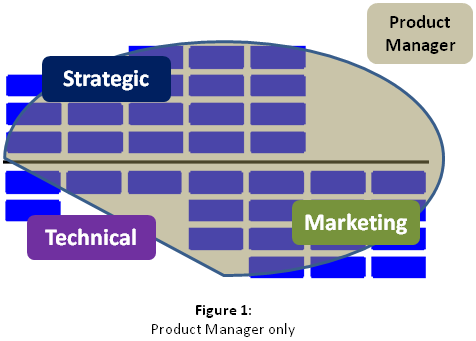
From my personal experience, then it is Product Marketing that has the most pressing requirement when initiating the Product Management function. Once the tactical product positioning and the immediate needs of the sales team (for B2B products) have been addressed, a comprehensive strategic product review (detailed competitive analysis, product road-mapping etc) can be undertaken. See the Webmetrics Case Study for a story of my own experience.
Product Manager + Product Marketing Manager
As the Product Management function matures, then usually the first division in a B2B product environment is to separate Strategic Product Management from Product Marketing. Again, Engineering usually retains the majority of the Technical Product Marketing, but the Strategic Product Management (the individual is usually called the 'Product Manager') now has some bandwidth to cover more of the Technical Product Management.
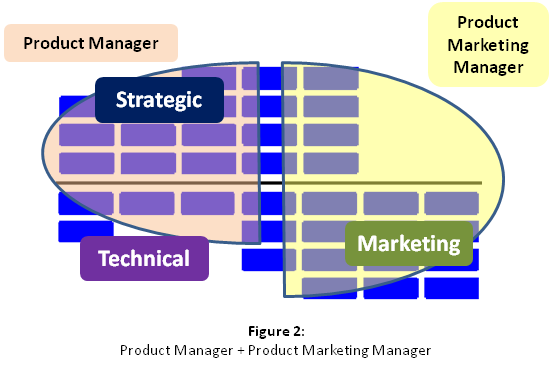
Strategic Product Manager + Product Marketing Manager + Technical Product Management
Finally, the glorious triumvirate of Product Management exists:
- Strategic Product Manager (aka 'Head of Product Strategy')
- Product Marketing Manager
- Technical Product Manager
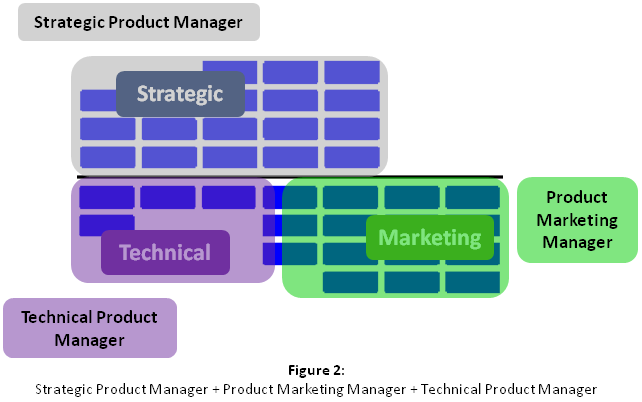
Multiple products = multiple Product Managers
Most companies have more than one product – and it is essential that each product has a nominated Product Manager. Obviously one person might be able to do several ‘small’ products. Balancing the time requirements between multiple products demands even more trade-offs – make sure your Product Manager has access to senior management for assistance with prioritisation!
Platform Plays
Frequently, there is a platform that underpins multiple products. I recommend that the platform has a (senior) product manager. The services or products that sit on top of the platform should each have their own designated product managers. In general, the service Product Managers tend to focus on Product Marketing and positioning, leaving much of the Strategic Product Management to the Platform Product Manager. Clearly, the platform Product Manager needs to closely coordinate activities with the other Product Managers – particularly roadmaps.
Further complexity is added when products have sub-products for different industries or products for different geographies – although these may be considered derivatives of the Platform + Product model.
Pragmatic Institute have an article which discusses this topic in more depth than I have: Multiple Products, Multiple Product Managers.
Product Management for B2C Products
This article discusses Product Management for B2B Products – principally because (numerically) more PMs work in enterprise products than consumer products.
B2C Product Management is different: the product IS the service – and today it is usually internet-based.
- There is no direct sales team, so the outbound messaging and delivery is direct to the customer via the product, app or via a website. Sometimes there are distribution channels or products for particular verticals, but this is too complex to discuss here!
- Product Strategy becomes elevated in importance.
- Product Marketing still exists, but in a more junior capacity – and frequently it has Marketing-esque functions – eg search engine optimisation, social media messaging monitoring. Indeed, it may not be called Product Marketing at all – this is the territory of ‘Product Evangelist' for example.
- User Experience and User Interaction becomes much more important – a function that frequently reports into Product Management, as a brother to Engineering department.
Who should the Product Manager report to?
Using the data from the Pragmatic Institute's Annual Survey, Product Managers, most commonly, report to CEO. If there’s a bevy of Product Managers, then the VP of PM reports to the CEO. The next most common channel is via the COO.
According to the survey, the, disturbingly, 40% of PMs report to either Marketing, Sales or Engineering. These are inappropriate 'homes' for Product Management. This organisational structure creates a ‘blind spot’, frequently, the very blind spot that Product Management is intended to solve.
| If Product Management reports to.... | then this results in Product Management becoming a .... |
| Sales | Demo jockey |
| Marketing | Collateral Dude |
| Engineering | Spec King |
In conclusion, the CEO or COO only please! For more information, see Pragmatic Institute’s article: Where Does Product Management Belong in the Organization?.
Initiating Product Management processes in your organisation
Good news - even if there is no-one called a Product Manager in your organisation, the Product Management function DOES exist already! Unfortunately, it will be scattered across the organisation, done intermittently, inconsistently, unknowingly and with little coordination with anyone else! (See Rule 1: If product managers doesn't do their jobs, the other departments will fill the void of Practical Rules for Product Management)
When a 'first in post' Product Manager is appointed, there needs to be an ‘inventory check’ of Product Management functions + their current owners, followed by a decision on who should own what. (Hint: the Pragmatic Framework is a great start! Double hint: Download the PowerPoint version. )
This usually uncovers a vast mound of unresolved issues which require PM attention and (recruiters take note) frequently leads to the need for more hires. And it is the first great test of the Product Manager's diplomatic skills!
Side Note: New Product Managers may find this infographic useful Your New Product Manager Job. This was a collaborative effort in conjunction with Product Focus.
Further Reading
- Product Management Interview Questions
- My blog posts on Product Management
Feedback
Do bookmark this article for future reference. And do comment on this article or contact me directly.